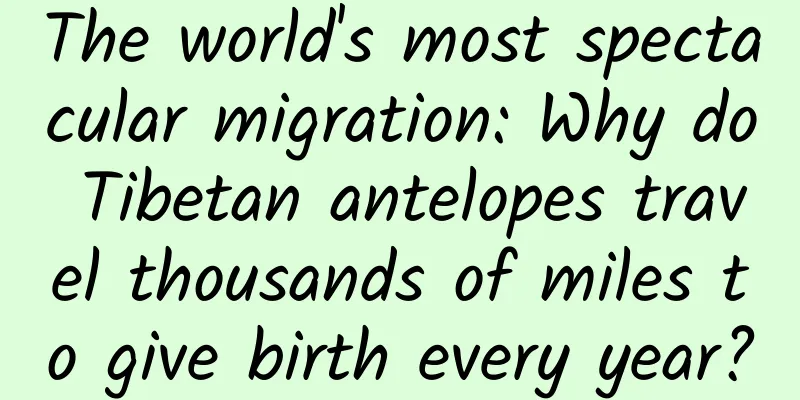The world's most spectacular migration: Why do Tibetan antelopes travel thousands of miles to give birth every year?

|
Science Times reporter Zhang Yun The famous annual scene is here! On May 7, in the "forbidden zone of life" Hoh Xil, groups of Tibetan antelopes set out on a thousand-mile journey, crossing the Qinghai-Tibet Railway and Qinghai-Tibet Highway to the "big delivery room" Zhuonai Lake and Taiyang Lake to "give birth" together. The migration of Tibetan antelopes is one of the three most spectacular migrations of ungulates in the world. From May to August every year, female Tibetan antelopes from different regions of the Qinghai-Tibet Plateau gather in groups and go to birthing grounds thousands of miles away to give birth, and then return with their lambs along the same route, completing the migration journey of life. Why do Tibetan antelopes migrate for generations? How do they choose their migration routes? And how do they "navigate" to their destinations? "The migration patterns of Tibetan antelopes have always been a blank in the field of international wildlife research." Wu Xiaomin, a researcher at the Shaanxi Institute of Zoology, said in an interview with the Popular Science Times on May 9 that since 2013, he and his team have been equipping Tibetan antelopes in Qinghai's Hoh Xil and Tibet's Qiangtang with Beidou satellite positioning systems, genetic diversity, and air-space integration research to record the migration routes and migration times of Tibetan antelopes in order to uncover the mystery of Tibetan antelope migration, and the research is still in progress. "Up to now, all the motivations for the migration of Tibetan antelopes in the industry are mostly guesses and assumptions, and there is no conclusion." Wu Xiaomin said. Chen Jiarui, an associate professor at Qinghai University, and her research team are engaged in the protection of wildlife on the Qinghai-Tibet Plateau, and the adaptation and evolution of plateau animals. She told reporters that the main reasons for the migration of Tibetan antelopes are to avoid solid precipitation, nutrition, parasites, and paleoclimate and environmental driving theories. "At present, our research team has proposed the paleoclimate and environmental driving theory, that is, the migration behavior is the collective memory formed by the Tibetan antelopes in the process of adapting to the long-term geological and historical climate events of the Qinghai-Tibet Plateau." From killing to rebirth, from endangered to vulnerable, protecting Tibetan antelopes has become a consensus of mankind. Wu Xiaomin said that the number of Tibetan antelopes once dropped from millions in the prosperous period to 60,000 to 70,000 in the 1980s and 1990s. After decades of unremitting efforts to protect the population and restore the habitat, the number of Tibetan antelopes on the Qinghai-Tibet Plateau has recovered to more than 300,000 today. "Some net fences that may affect the safe passage of Tibetan antelopes have been removed from the migration corridors of Tibetan antelopes on the Qinghai-Tibet Plateau. Tibet has implemented the relocation of Tibetan antelope habitats, and the "bridge instead of road" of the Qinghai-Tibet Railway has made way for Tibetan antelopes. These measures aim to clear all factors that hinder the migration of Tibetan antelopes and enable ewes to return with their lambs smoothly." After years of research, Wu Xiaomin and his team have achieved a series of interim research results in the accurate migration time and route of Tibetan antelopes, migration distance and daily migration distance, arrival and departure time of the birthing grounds, as well as the activity range of Tibetan antelopes in the birthing grounds, habitats and the ecological environment status of the birthing grounds. However, there are still many unsolved mysteries about the "plateau elves". Experts believe that the migration of Tibetan antelopes is a special scientific issue. Unlike the migration of birds, insects or African grassland animals, the particularity of the species itself and its living environment makes it very difficult for scientific researchers to study it. |
<<: This little bug's "kiss" may have troubled Darwin throughout his life...
Recommend
The efficacy and contraindications of Tiepi Fengdou
Nowadays, many friends have given up choosing som...
The efficacy and edible methods of Phellinus igniarius
Phellinus versicolor is a bacterium that is famou...
What does mint do?
What are the effects of mint? Most people don'...
The efficacy and function of yellow bark
Huangpi tree bark is a very nutritious and precio...
Resembling "Hot Wheels", the Nomin River volcano group "appeared on camera"!
The Nuominhe volcanic group in the Oroqen Autonom...
Zhuge Liang managed to fool the Eastern Wu just by talking?
Mixed Knowledge Specially designed to cure confus...
Emergency consultation: Who sealed Shen Gongbao's throat?
The total box office of the movie "Nezha: Th...
The efficacy and function of the bone-breaking tree
I believe many people are familiar with the Chine...
Heartbroken! Two boys in Hangzhou drowned in swimming pools! Pediatric experts: In addition to rivers and ponds, swimming pools have become a high-risk area for drowning
Summer vacation is here and the heat is unbearabl...
Holding back anger can really cause internal damage! Psychologists analyze the whole process of harming your body
How harmful can anger be to your health? A study ...
Written after DeepSeek became popular: AI is developing so fast, will it develop faster and faster in the future?
Produced by: Science Popularization China Author:...
Why do I always feel my heart pounding?
Oops, I feel excited again! In life, many people ...
The efficacy and function of Amaryllis
Only when we understand the main ingredients of a...
The role of traditional Chinese medicine Polygonum multiflorum
Many of our friends may not know much about the e...









